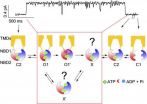(Press-News.org) LEXINGTON, Ky. (Sept. 26, 2012) — A study by a team of University of Kentucky researchers has shed new light on the potential habit-forming properties of the popular pain medication tramadol, in research funded by the National Institute on Drug Abuse. The paper is slated to appear in an upcoming edition of the academic journal Psychopharmacology.
Prescription pain killer abuse is a major public health problem in the U.S. In 2010, more individuals over the age of 12 reported nonmedical use of prescription pain relievers in the past month than use of cocaine, methamphetamine or heroin.
"Prescription pain pill abuse is a real problem in Kentucky. We have lots of overdoses. We held a summit here in February specifically about partnering law enforcement and medicine to tackle this problem," said lead study author William W. Stoops of the UK College of Medicine Department of Behavioral Science, the UK Center on Drug and Alcohol Research (CDAR) and the UK College of Arts and Sciences Department of Psychology.
Other UK authors include: Michelle R. Lofwall, Paul A. Nuzzo, Lori B. Craig, Anthony J. Siegel and Sharon L. Walsh.
The study utilized a double-blind, placebo-controlled design. Participants were given one of 12 possible dose combinations of placebo, tramadol, naltrexone and hydromorphone. Naltrexone is an opioid receptor blocker, used to attenuate the effects of opioid medications. Following drug administration, participants were evaluated based on self-reported measures, observer-reported measures, ocular measurements (such as pupil dilation) and performance tasks. Ten participants completed the study.
It was expected that if both tramadol and hydromorphone (Dilaudid®), a common opioid analgesic, acted similarly upon the nervous system, administering naltrexone would mitigate the effects of both drugs in a similar fashion. What was found was that while participants given both hydromorphone and naltrexone reported a lack of influence by the drug, patients taking tramadol and naltrexone reported still feeling "high". Participants who received hydropmorphone or tramadol with placebo also reported feeling affected.
"When we've given them placebo and the opioid receptors are not blocked, tramadol and hydromorphone produce fairly similar effects," said Stoops. "They make subjects say that they're high, they make subjects say that they like the drug, those kind of things. Tramadol does produce some bad effects; folks are saying that it makes them a little nauseous so it is a little distinct from hydromorphone in that manner, which is important. When we gave folks naltrexone, when we blocked those opioid receptors, hydromorphone didn't produce any effects, it was like we'd given them placebo. It completely blocked the effects of hydromorphone because the primary way hydromorphone works is on the opioid receptors in the brain; they're blocked so of course hydoromorphone isn't going to produce an effect. With tramadol, we did not see anywhere near the blockaded effect that we saw with hydromorphone. We need to test a higher naltrexone dose to confirm that this is the case."
The overall results of the study indicated that on measures such as "liking" and "street value," participants rated tramadol highly, suggesting an increased potential for abuse. However, in order to reach these favorable ratings, participants had to take doses well above the normal therapeutic range, and into a range which also produced several negative side effects such as gastrointestinal illness, vomiting and feeling unwell.
"The important thing about this is I think we all assumed that any abuse of tramadol or any abuse potential tramadol had was because of the way it activated the opioid receptors in the brain and that may not be the case," said Stoops "It's pretty well accepted that with opioid drugs like oxycodone, hydromorphone and hydrocodone, when you block the opioid receptors in the brain, folks aren't going to abuse the drug. That is not the case for tramadol. Opioid receptors are important in tramadol use and abuse, but they appear to not be the entire story."
### END
University of Kentucky research sheds light on pain pill abuse
2012-09-26
ELSE PRESS RELEASES FROM THIS DATE:
New insights into functionality of cystic fibrosis protein
2012-09-26
CFTR is an important protein that, when mutated, causes the life-threatening genetic disease cystic fibrosis. A study in The Journal of General Physiology (JGP) details how an accidental discovery has provided new understanding about CFTR functionality.
From a scientific standpoint, CFTR is unique in that it is the only known ion channel—a protein pore that enables the passive diffusion of ions across cell membranes—in the enormous superfamily of ABC proteins, which normally operate as active transporters. As active transporters, ABC proteins use energy derived from ...
Paper: Federal law needed to safeguard 'digital afterlives'
2012-09-26
CHAMPAIGN, Ill. – Federal law ought to play a stronger role in regulating social networking sites by allowing users to determine what happens to their "digital afterlives," says a recently published paper by a University of Illinois expert in intellectual property law.
Allowing social networking sites to set their own policies regarding the content associated with the accounts of deceased users does not adequately protect individual and collective interests, especially with people spending an increasing part of their lives online using social networking sites, says Jason ...
Duke Medicine news -- Protein structure unlocks 1 mystery of multi-drug tolerance
2012-09-26
DURHAM, N.C. – The structures of key bacterial proteins have revealed one of the biochemical secrets that enables bacteria to outwit antibiotics.
In a paper published Sept. 20, 2012 in the journal Cell Reports, Duke University School of Medicine researchers and their colleagues describe the results of a series of experiments exploring multi-drug tolerance, a phenomenon that allows bacteria to become dormant and tolerate antibiotics, only to later awaken and re-infect the host. Drug tolerance is a factor in several types of stubborn, recurring infectious diseases caused ...
Taking the battle against the toxic trio beyond 'Leaves of 3, leave it be'
2012-09-26
With more than half of all adults allergic to poison ivy, oak and sumac, scientists are reporting an advance toward an inexpensive spray that could reveal the presence of the rash-causing toxic oil on the skin, clothing, garden tools, and even the family cat or dog. Using the spray, described in ACS' The Journal of Organic Chemistry would enable people to wash off the oil, or avoid further contact, in time to sidestep days of misery.
Rebecca Braslau and colleagues explain that allergic reactions to oils of the toxic trio are more than a nusiance. They claim a huge human ...
Bigger wind turbines make greener electricity
2012-09-26
WASHINGTON, Sept. 26, 2012 — The latest episode in the American Chemical Society's (ACS') award-winning Global Challenges/Chemistry Solutions podcast series concludes that the larger the wind turbine, the greener the electricity it produces. The study could solidify the trend toward construction of gigantic windmills.
Based on a report by Marloes Caduff in ACS' journal Environmental Science & Technology, the new podcast is available without charge at iTunes and from www.acs.org/globalchallenges.
In the new episode, Caduff, a graduate student, and Stefanie Hellweg, ...
Exposure to snot-nosed kids ups severity of cold infections
2012-09-26
Exposure to school-age children raises the odds that a person with lung disease who catches a cold will actually suffer symptoms like a runny nose, sore throat and cough, according to a study just published in the Journal of Clinical Virology.
That finding, the result of a study that drew upon a databank of 1,000 samples of sputum and nasal secretions from people with chronic obstructive pulmonary disease or COPD, comes as a surprise, says Ann Falsey, M.D., professor of Medicine at the University of Rochester and an infectious disease expert at Rochester General Hospital. ...
Buddhist statue, discovered by Nazi expedition, is made of meteorite, new study reveals
2012-09-26
It sounds like an artifact from an Indiana Jones film; a 1,000 year-old ancient Buddhist statue which was first recovered by a Nazi expedition in 1938 has been analysed by scientists and has been found to be carved from a meteorite. The findings, published in Meteoritics and Planetary Science, reveal the priceless statue to be a rare ataxite class of meteorite.
The statue, known as the Iron Man, weighs 10kg and is believed to represent a stylistic hybrid between the Buddhist and pre-Buddhist Bon culture that portrays the god Vaisravana, the Buddhist King of the North, ...
Women twice as likely to suffer infection with kidney stones and other urinary blockages
2012-09-26
DETROIT– While more men than women develop kidney stones and other obstructions in the urinary tract, women are more than twice as likely to suffer infections related to the condition, according to a new study led by Henry Ford Hospital researchers.
The researchers also found significantly higher rates of complications following one of two urgent treatments for the effects of urolithiasis – or stones in the kidneys and urinary tract – but stressed that this finding is based on preliminary and more research is needed.
The findings were published today in the peer-reviewed ...
Tracking koala disease: New findings from old DNA
2012-09-26
DNA extracted from the skins of koalas displayed in European and North American museums shows that a retrovirus has been a problem for the animals for much longer than was thought, according to Alfred Roca, an assistant professor of animal sciences at the University of Illinois, and Alex Greenwood of the Leibniz Institute for Zoo and Wildlife Research (LZW) in Berlin.
"The process by which a retrovirus invades the host germ line appears to be quite drawn out in this case, so that the koala population has suffered the strongly pathological effects of the virus for many ...
Research breakthrough opens door to new strategy for battling HIV
2012-09-26
New research showing how the HIV virus targets "veterans" or memory T-cells could change how drugs are used to stop the virus, according to new research by George Mason University.
The research will appear in the Journal of Biological Chemistry's October edition and currently is available online.
"It's a big breakthrough for us," says Yuntao Wu, an author of the study and professor at the Mason-based National Center for Biodefense and Infectious Diseases. "I think this will impact the field."
Helper T-cells support the body's immune system by organizing forces to ...

